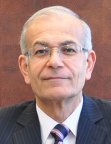Advanced technologies in Product Design, Engineering and Manufacturing - ACADEM2013

Ahmad Nasri is a professor in computer graphics at the American University of Beirut. He received a BS degree in Mathematics from the Lebanese University in 1978, and a Ph.D in Computer Graphics from the University of East Anglia in 1985. He was a research visitor at various universities such as MIT, Arizona State University, Calgary University, Purdue University, Brigham Young University, Seoul National University, City University of Hong Kong, University of Geneva, Cambridge University, and Nanyang Technological University in Singapore. He is on the editorial board of the Visual Computer Journal, the International Journal of Shape Modeling, the International Journal on Software and Informatics, and The International Journal of CAD/CAM. He served on the PC of numerous international conferences in computer graphics and Geometric modeling, and acted as referees of most of the journals in the fields.
He published over 70 papers in prestigious journals and conference proceedings, which contributed solutions to various problems in the field including the co-foundation of T-spline.
With Malcolm Sabin he co-edited a special issue of the Journal of Visual Computer on Subdivision surfaces, 2002. Since 1982 he has been involved in promoting subdivision surfaces and its use in computer graphics, geometric modeling, animation, and digital arts. In addition to Subdivision Surfaces, his research interests include cultural heritage, Digital Arts, and the use of Computer Graphics in Education.
Guido Brunnett is a full professor of computer graphics in the Chemnitz University of Technology's Computer Science Department. He also directs the Institute of Mechatronics, a private research institute affiliated with the university. Brunnett has a PhD in computer science from the University of Kaiserslautern and a diploma in mathematics from the University of Dortmund. His research interests include geometric modeling, CAD/CAM applications, virtual reality and virtual humans.
Georgios Nikolakopoulos is an Assistant Professor in the Faculty of Automatic Control Systems at the Control Engineering Group at the Division of Systems and Interaction (Lulea University of Technology, Sweden). His main research interests encompass fields, such as: Networked Controlled Systems, Field Robotics, Wireless Sensor Networks & Actuators, AUV, UAVs, Applied Automatic Control Systems, Adaptive & Robust Control, System Identification, Fault Detection, MEMs.
In the past he has been project manager in several R&D projects funded form EU, ESA, and the Greek National Ministry of Research. In year 2003, he has received the Information Societies Technologies (IST) Prize Award, for the best paper that promotes the scopes of the European IST (currently known as ICT). His published scientific work includes more than 120 published International Journals and Conferences in the above fields. Moreover he served as IPC member for CASE'2010, ETFA'2010, ECC'09, MED'09, MIC'09, and MIC'10 international conferences, and have been Associate Editor and Reviewer of several International Journals and conferences. From 2006-2012, he is a member of the IASTED Control Technical Committee.

Ioannis Fudos is an Associate Professor at the Department of Computer Science of the University of Ioannina. He received a diploma in computer engineering and informatics from University of Patras, Greece in 1990 and an MSc and PhD in Computer Science both from Purdue University, USA in 1993 and 1995, respectively. His research interests include animation, rendering, morphing, CAD systems, reverse engineering, geometry compilers, solid modelling, and image retrieval. He has published in well-established journals and conferences and has served as program committee member and reviewer in various conferences and journals. Dr Fudos has obtained funding from the EC and national sources. He has coordinated a number of national projects and bilateral cooperations and has participated in the coordination and high level administration of several EC projects. Dr Fudos has long research experience in CAD where he has conducted influential research on geometric constraint solving and jewelry reconstruction. Fudos has also worked on graphics, visualization and other areas of computer science such as sensors, social networks and hardware design.